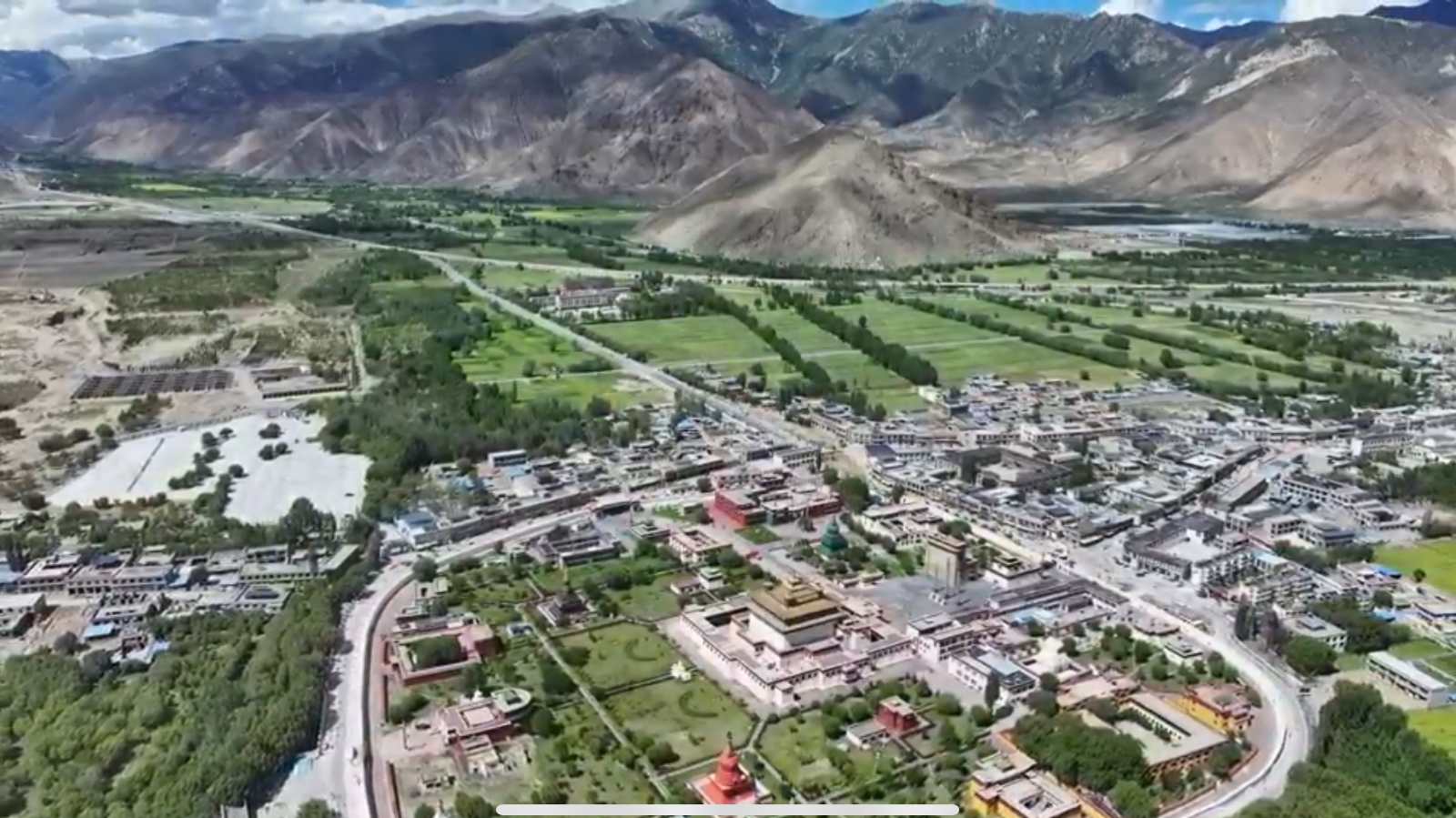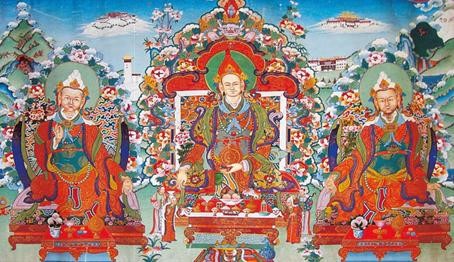The Kathog Rigzin Chenpo Lineage Masters
Brief Account of the Origins of the Kathog Rigzin's Incarnations and the Biography of Scholar Rinchen Tsewang Norbu's Reincarnations
The origins of this renowned scholar of Eastern Tibet's Kathog Monastery are as follows: His dharmakaya is Amitabha Buddha, his sambhogakaya is Vajradharma, and his nirmanakaya is Guru Padmasambhava. Dwelling in the realm of profound wisdom, his reincarnations arise from the aspiration power of the natural three kayas and beings' karmic connections...
During the time of Shakyamuni Buddha, he manifested as Master Upali among the eighty mahasiddhas. In medieval India, he reincarnated as the siddha Krishnacharya (the Black Practitioner), then as Gunabhadra who mastered the vinaya and possessed the six ornaments of the world. Subsequently, he manifested as the guru of Kunapa, as Hungkara - one of the Eight Vidyadharas; as Namkhai Nyingpo of the Nu clan, one of Guru Rinpoche's five fortunate heart disciples; among the 108 great treasure revealers, he appeared as Chador Gyatso Lingpa and Dakpa Panchen; as Sazang Mahapandita among Dolpopa's fourteen heart disciples of the Jonang tradition; and as Tsangton Dorje Gyaltsen among the three founding masters of Kathog. Like a garland of lotus flowers, these incarnations continued uninterrupted until he manifested with the dharma name Kathog Rigzin...
From the Second incarnation onwards, due to inconceivable aspiration power, he had manifestations in both Kathog and Jonang traditions, each being recognized and enthroned. Thus, his manifestations in these two lineages are described separately below.
In the Jonang incarnation lineage, the present Kathog Rigzin Padma Wangchen Rinpoche is considered the Ninth incarnation, while in the Kathog lineage he is the Sixth incarnation, as detailed in the following reference:
1st
Sasang Mati Panchen (1294-1376)
ས་བཟང་མ་ཏི་པཎ་ཆེན། །
薩桑 瑪底 班千
薩桑瑪底班禪尊 (1294-1376)
སྐུ་ཕྲེང་དང་པོ།
རི་ཧི་མ་ལ་ཡི་བྱང་གི་ཕྱོགས། །
མངའ་རིས་སྟོད་ཀྱི་ས་ཆ་ལ། །
སྐུ་བཙས་མ་ཐག་ནས་ཆོས་གསུངས་པའི། །
ས་བཟང་མ་ཏི་པཎ་ཆེན་ལ། །
སྙན་མོ་གླུ་ཡི་མཆོད་པ་འབུལ། །
དབྱངས་མཆོད་པ་འབུལ་ལོ་བཞེས་སུ་གསོལ། །
The First Incarnation
In the northern reaches of Himalaya,
In the sacred land of Upper Ngari,
To the one who taught dharma from birth itself,
To Sazang Mati Panchen I bow.
I offer this melodious song of praise,
Please accept this musical offering of devotion.
The First Incarnation
Sazang Mati Panchen (1294-1376), whose dharma name was Lodro Gyaltsen, was born in the Ngari region. By the age of four, he had mastered the Five Treatises of Maitreya. He became one of Tibet's most renowned scholars, one of the fourteen great disciples of Master Dolpopa, and one of the teachers of Je Tsongkhapa. Five volumes of his written works survive to this day.
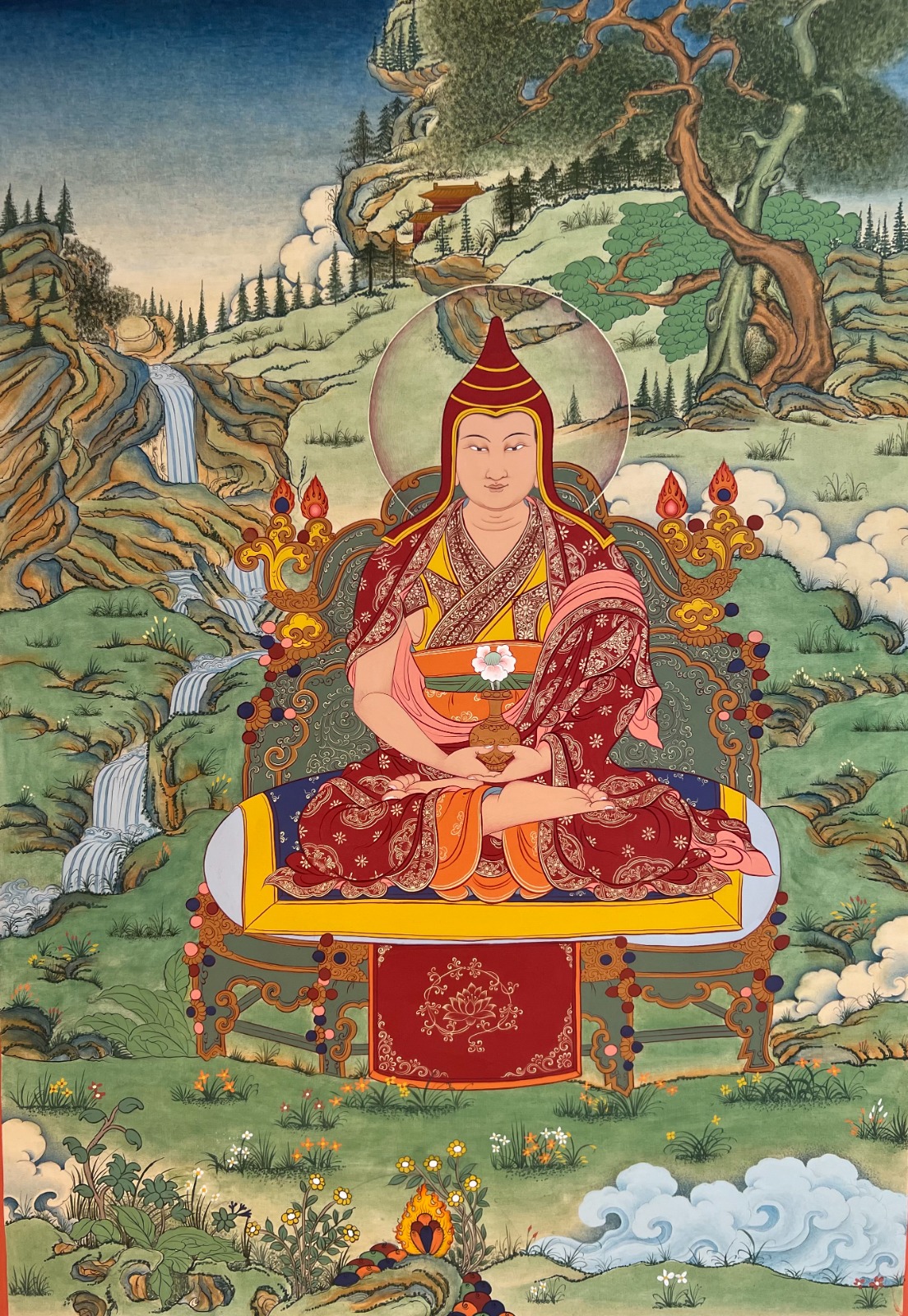
2nd
Jetsun Kunga Chokdrub Panchen (1420 - 1550)
རྗེ་བཙུན་ཀུན་དགའ་མཆོག་གྲུབ་ལ། །
傑尊 更噶 秋珠拉 (1420 - 1550)
皆喜勝成
སྐུ་ཕྲེང་གཉིས་པ།
གནས་ཇོ་ནང་དཔལ་གྱི་རི་ཁྲོད་ནས། །
སྐུ་སྤངས་ཏེ་ཤམྦྷ་ལ་རུ་བྱོན། །
སླར་ཡང་སྒྱུ་མའི་ལུས་ལ་ཞུགས། །
རྗེ་བཙུན་ཀུན་དགའ་མཆོག་གྲུབ་ལ། །
སྙན་མོ་གླུ་ཡི་མཆོད་པ་འབུལ། །
དབྱངས་མཆོད་པ་འབུལ་ལོ་བཞེས་སུ་གསོལ། །
The Second Incarnation
From Jomonang's sacred hermitage,
Casting off his form, he journeyed to Shambhala.
Once more, he entered an illusory body.
To Lord Kunga Chokdrub I bow.
I offer this melodious song of praise,
Please accept this musical offering of devotion.
The Second Incarnation
Jetsun Kunga Chokdrub (1420-1550) studied all traditions of Tibetan Buddhism and propagated the definitive Zhentong view and Dzogchen teachings. He spent twelve years in retreat practicing the Six-Branch Yoga of Kalachakra, gaining mastery over subtle energies and consciousness, and achieved alchemical accomplishments. Through his illusory body, he travelled to the pure land of Shambhala to receive teachings. He lived to around one hundred and thirty years of age, ultimately dissolving his illusory body into the body of Kalachakra. Among his renowned disciples was Kunga Drolchok.
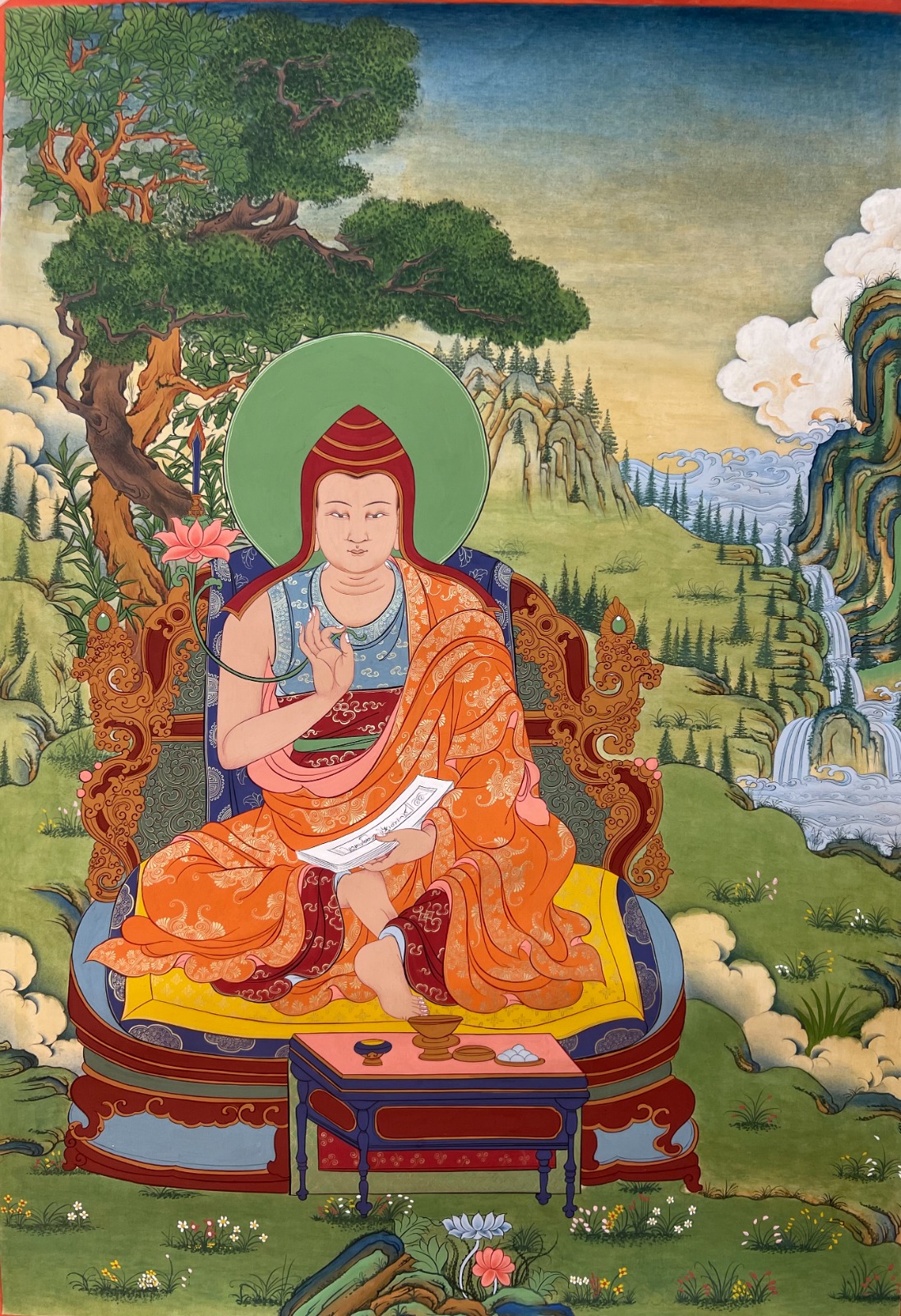
3rd
Tingkye Gyalse Panchen (1584-1632)
རྗེ་བཙུན་བླ་ཆེན་ཡེ་ཤེས་རྒྱ་མཚོ། །
喇欽耶西 嘉措 (1584-1632)
文殊大海
སྐུ་ཕྲེང་གསུམ་པ།
དཔལ་དུས་ཀྱི་འཁོར་ལོའི་ཉམས་ལེན་ལ། །
སྒོ་འདམ་སྦྱར་བྱས་ནས་ལོ་གསུམ་བཞུགས། །
རླུང་དབུ་མར་ཞུགས་པས་ཉམས་རྟོགས་བྱུང་། །
འཇམ་དཔལ་ཡེ་ཤེས་རྒྱ་མཚོ་ལ། །
སྙན་མོ་གླུ་ཡི་མཆོད་པ་འབུལ། །
དབྱངས་མཆོད་པ་འབུལ་ལོ་བཞེས་སུ་གསོལ། །
The Third Incarnation
In the practice of glorious Kalachakra,
Three years he dwelt in complete seclusion.
When winds entered the central channel, realisation dawned.
To Jampal Yeshe Gyatso I bow.
I offer this melodious song of praise,
Please accept this musical offering of devotion.
The Third Incarnation
Prince Tingkyi, whose dharma name was Yeshe Gyatso (1584-1632), was born into the Tingkyi royal family. The venerable master Taranatha recognised him as the incarnation of Sazang Panchen and performed his enthronement ceremony, while also acknowledging him as another of his own manifestations. He studied extensively with the Sakya, Nyingma, and Gelug schools of Tibetan Buddhism and became highly renowned. He completed a three-year and three-month retreat practicing Kalachakra, attaining the ten great signs of accomplishment. His written works include unique Kalachakra empowerments, commentaries on Chakrasamvara and the Six Transmissions, and explanations of the Great Middle Way philosophy.
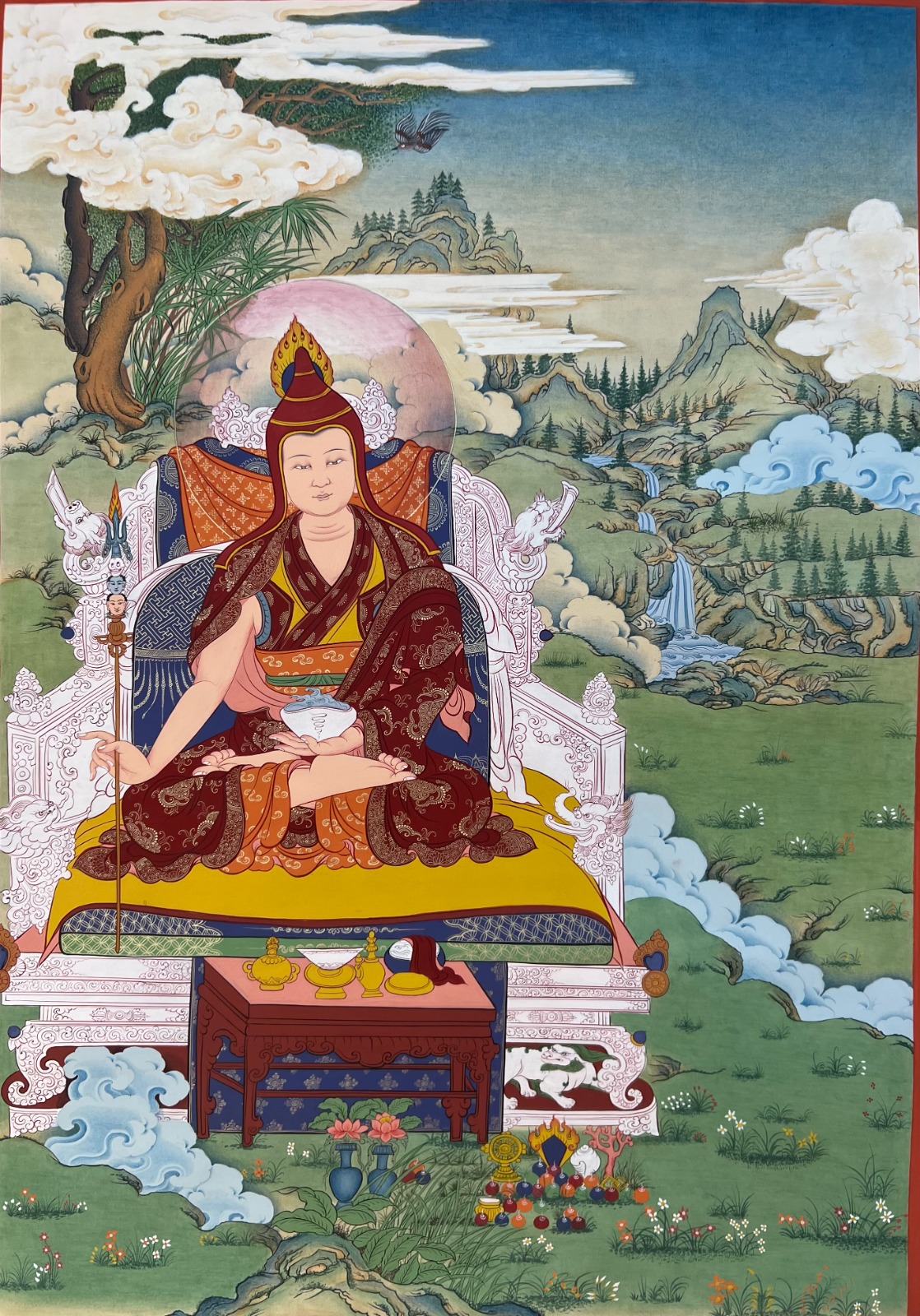
4th
1st Rigzin Chenpo Pema Norbu (1599-1679)
རིག་འཛིན་ཆེན་པོ་པདྨ་ནོར་བུ། །
仁珍 千寶 貝瑪 諾布拉(1599-1679)
蓮花珍寶
སྐུ་ཕྲེང་བཞི་པ།
དག་པ་གནས་ནང་གི་རི་ཁྲོད་དུ། །
ལོ་བདུན་བྱང་ཆུབ་སེམས་ལ་སྦྱངས། །
རྩོལ་མེད་སྙིང་རྗེ་ཐུགས་ལ་འཁྲུངས། །
རིག་འཛིན་པདྨ་ནོར་བུ་ལ། །
སྙན་མོ་གླུ་ཡི་མཆོད་པ་འབུལ། །
དབྱངས་མཆོད་པ་འབུལ་ལོ་བཞེས་སུ་གསོལ། །
The Fourth Incarnation
In the hermitage of sacred Nenang,
For seven years he trained in bodhicitta,
Effortless compassion arose in his heart.
To Rigzin Pema Norbu I bow.
I offer this melodious song of praise,
Please accept this musical offering of devotion.
(This marks the beginning of the Katog lineage, believed to be the First Kathog Rinchen Pema Norbu.)
Katog Mahavidyadhara (Rinchen Terdzod), Rinchen Pema Norbu (1599-1679), whose dharma name was Kunsang Chime, studied all Katog teachings under two Katog treasure revealers, Dundro and Longsal. He studied many classical Buddhist texts with the great master Pema Lodro, spent seven years in mountain retreat cultivating bodhicitta, and passed most of his life in meditation retreat.
The Second incarnation, in his composition "Wish-Fulfilling Garland," includes a prayer that states: "In Kham Mushi, especially the reincarnation of Rika 'Supreme Vidyadhara Heruka,' whose view combines practice and whose dharma power is complete, to Master Pema Norbu I pray." This clearly indicates that the master was born in Rika village in the Kham region.
The master received Buddhist teachings and bodhisattva vows from the scholar Rinchen Dundro Dorje, studied the path to enlightenment and meditation from the scholar Pema Lodro, and later spent seven continuous years in the solitude of Nenang developing bodhicitta and meditating, cultivating the natural compassion in his heart.
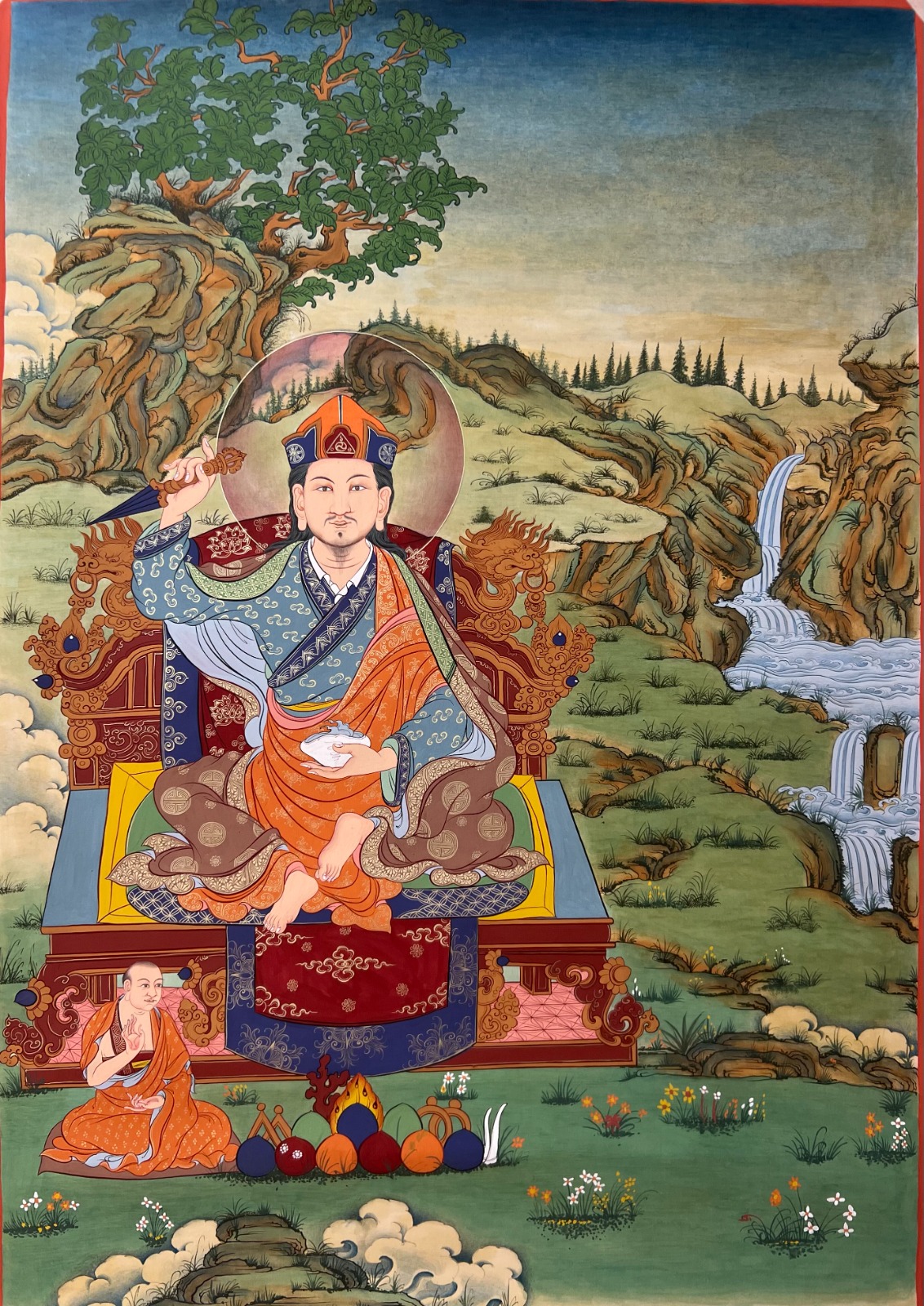
5th
2nd Rigzin Chenpo Tsewang Norbu (1698-1755)
རིག་འཛིན་ཆེན་པོ་ཚེ་དབང་ནོར་བུ། །
仁珍 千寶才旺 諾布(1698-1755)
壽自在寶
སྐུ་ཕྲེང་ལྔ་པ།
ཁྱེད་འཁྲུངས་ས་མདོ་ཁམས་ཡུལ་དུ་འཁྲུངས། །
འཕྲིན་ལས་ནམ་མཁའི་མཐའ་དང་མཉམ། །
འགྲོ་དོན་ལ་ཕྱོགས་རིས་མེད་པའི་མགོན། །
རིག་འཛིན་ཚེ་དབང་ནོར་བུ་ལ། །
སྙན་མོ་གླུ་ཡི་མཆོད་པ་འབུལ། །
དབྱངས་མཆོད་པ་འབུལ་ལོ་བཞེས་སུ་གསོལ། །
The Fifth Incarnation
Born in the realm of Do-Kham you were,
Your enlightened activities vast as space itself.
Protector who serves all beings without bias,
To Rigzin Tsewang Norbu I bow.
I offer this melodious song of praise,
Please accept this musical offering of devotion.
The Fifth Incarnation (the second in the Kathog lineage)
Rinchen Tsewang Norbu (1698-1755) achieved remarkable accomplishments:
He was renowned as the great master of thirteen regions in the Himalayas, with numerous disciples, notably serving as teacher to the Seventh Dalai Lama, the Karmapa, a Nepali king, two kings of Ladakh, and the king of Derge. He selflessly restored three great stupas in Nepal, revived over a hundred Katog monasteries, and established the Rinchen Terdzod lineage.
He authored eight books, including complete practice manuals and essential instructions on Mahamudra and Dzogchen. He was particularly known for promoting the Shangpa Kagyu and Jonang teachings, becoming one of the pioneers of the non-sectarian movement in Tibetan Buddhism.
Born in 1698 near the famous Dharma Dedeu in Western Kham's Dzakhog highlands, he was recognised by the treasure revealer Pema Dechen Lingpa as his former teacher's reincarnation. Along with Druwo Rinpoche, they became his teachers, and he later emerged as a renowned master. The Derge king and Lama Sonam Drakpa conducted his enthronement ceremony at Katog Monastery.
Later, travelling to Central Tibet as an ordinary monk, he was identified by the Jonang leader Chokyi Kunsang Wangpo as the reincarnation of Sazang Panchen. He was enthroned and received all Jonang teachings.
As teacher to the Tibetan Regent Polhane, he shared mutual teacher-student relationships with the Black Hat Karmapa, the Red Hat scholar Situ Rinpoche, and the great Drukchen Rinpoche.
While restoring Nepal's Great Stupa, when the Nepali king initially created obstacles, his stern rebuke coincided with a city fire that ceased only upon the king's apology. He became famous for discovering treasure gold that required fifteen men to lift. During his journey to Mangyul Kyirong at the great Drukchen Rinpoche's invitation, he stopped a tent-sized boulder rolling down a mountain, demonstrating his accomplishment. His footprints remain in stones across many locations.
When the Nepali prince passed away, the king invited religious masters of all traditions to conduct the funeral rites, declaring: "Any accomplished master who can cremate the prince's body with natural fire will receive abundant offerings." Though requiring no offerings, the great Katog Rinpoche accepted. He pointed his mudra finger at the corpse, fire shot from his fingertip, and the body immediately ignited. When the king asked what he desired, he requested the abolition of a local evil custom, which the king granted. "This stands as one of the great Katog scholar's famous achievements in spreading the dharma," as some historians note.
Travelling at the Lhopa king's invitation, he passed 108 springs where a local spirit tried to create trouble. Recognising this, he entered meditation inseparable from his deity. A vajra appeared in his right hand, and singing vajra songs, he subdued the mountain spirit - a scene witnessed by all present. When people couldn't lift a long, heavy wooden pillar for the stupa from the forest, he touched it while reciting mantras, and instantly the pillar shot like an arrow to the stupa's edge. Once when the Nepali king reneged on his promise, his wrathful rebuke caused the king to perceive him as a fire-breathing wrathful deity, frightening him into fulfilling all the stupa's construction needs until the master's passing.
At the Seventh Dalai Lama's command, he travelled to Ladakh as Tibet's special envoy. When the southern Ladakhi king delayed meeting him, he composed a "Tara Prayer" and requested protector assistance. The king, seeing terrifying visions, rushed to meet the master but fainted upon sight. Upon awakening, he begged forgiveness and promised to follow the master's future guidance, thus resolving the matter.
He built many monasteries and restored hundreds of temples across Nepal (in Nuri, Shakyambu, etc.), Tibet (in Kongpo, Mangyul, etc.), Ladakh, Sikkim, Golok, and Dolpo.
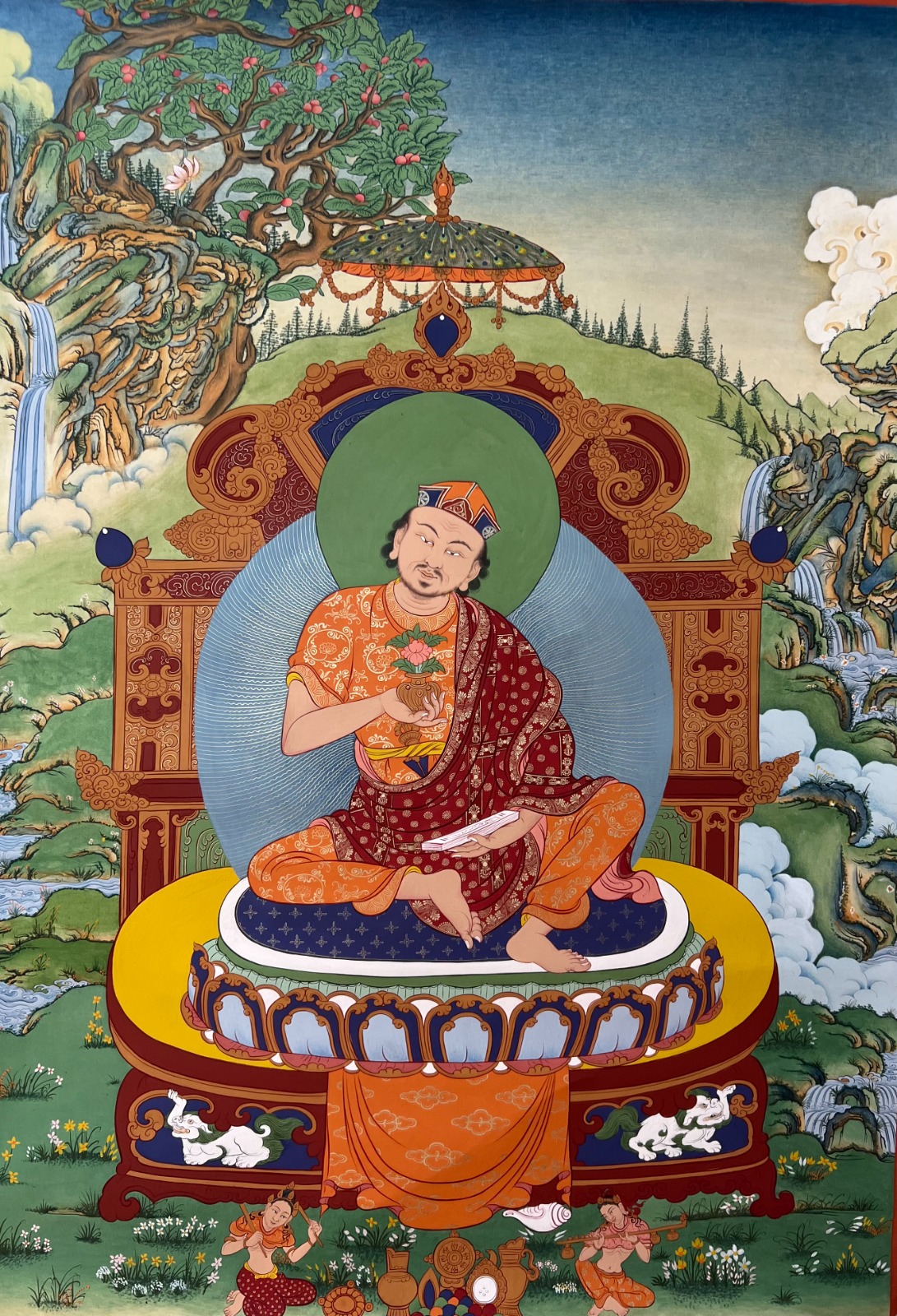
6th
3rd Rigzin Chenpo Tsering Tashi (1769-1780)
རིག་འཛིན་ཆེན་པོ་ཚེ་རིང་བཀྲ་ཤིས། །
仁珍 千寶 才仁 札西 (1769-1780)
長壽吉祥
སྐུ་ཕྲེང་དྲུག་པ།
ཁོང་རྒྱལ་དབང་འབྲུག་པ་ཆེན་པོ་དང་། །
བྱམས་མགོན་ཏཱ་ཡི་སི་ཏུ་སོགས། །
ཀུན་ལ་གཟིགས་སྣང་གཅིག་པ་བྱུང་། །
རིག་འཛིན་ཚེ་རིང་བཀྲ་ཤིས་ལ། །
སྙན་མོ་གླུ་ཡི་མཆོད་པ་འབུལ། །
དབྱངས་མཆོད་པ་འབུལ་ལོ་བཞེས་སུ་གསོལ། །
The Sixth Incarnation
The great Gyalwang Drukpa and The loving protector Tai Situpa, among others, All shared the same pure vision of him. To Rigzin Tsering Tashi I bow. I offer this melodious song of praise, Please accept this musical offering of devotion.
The Sixth Incarnation (the third in the Katog lineage) Rinchen Tsering Tashi (1769-1708) passed away shortly thereafter. In some ancient documents, he is referred to as Tashi Tsering. According to the prophecies left by the Second Rinchen Tsewang Norbu before his passing, the visions received in meditation by the renowned Shamarpa and the venerable Drukchen Rinpoche, and the prophecies received by Pawo Rinpoche during his retreat at Kongpo Rainbow Cave...
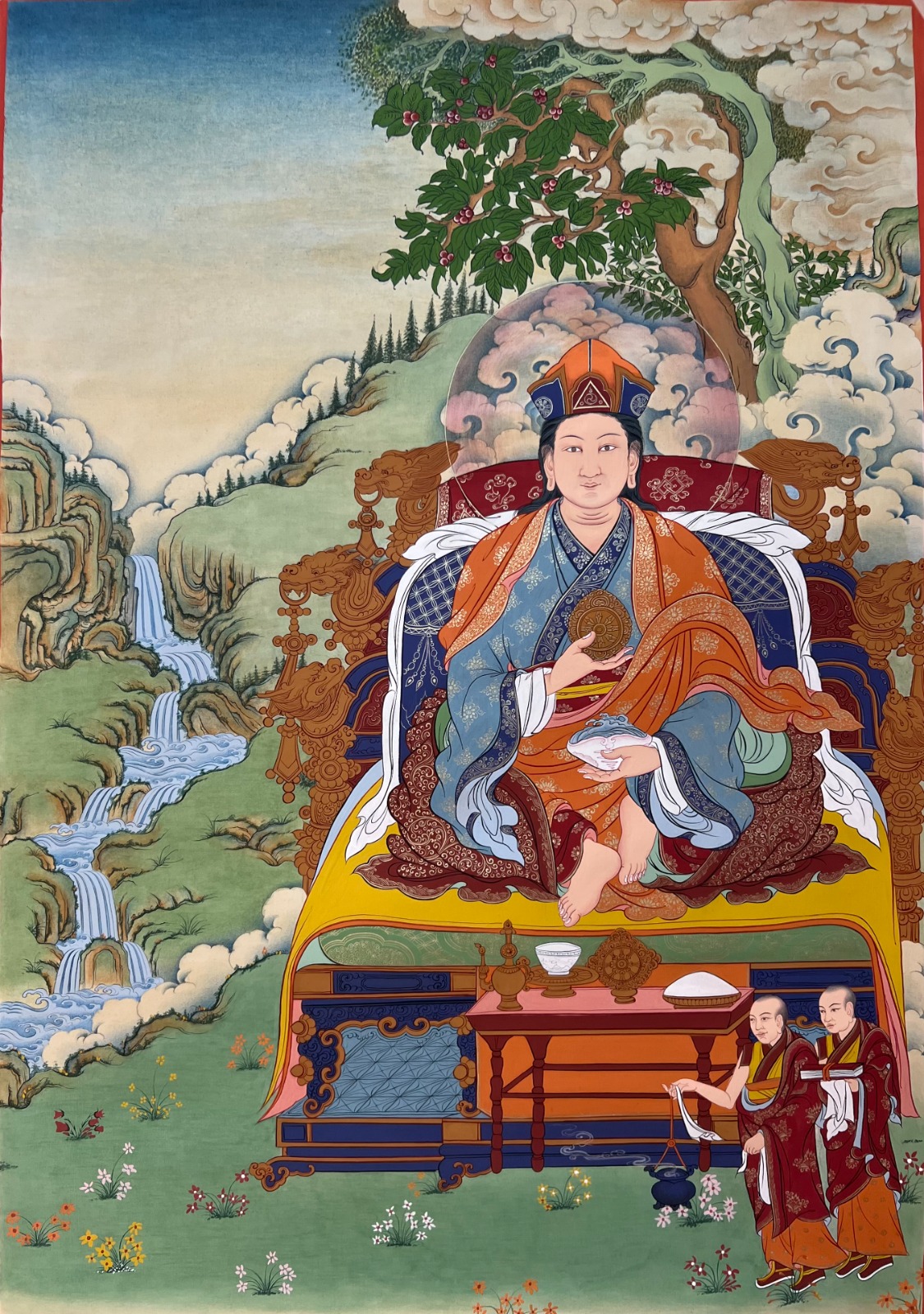
7th
4th Rigzin Chenpo Lekyi Dorje (1792-1872)
རིག་འཛིན་ཆེན་པོ་ལས་ཀྱི་རྡོ་རྗེ །
仁珍 千寶 雷格 多傑 (1792-1872)
事業金剛
སྐུ་ཕྲེང་བདུན་པ།
སྐུ་ཆུང་ངུའི་དུས་ནས་བྱ་བྲལ་ཕེབས། །
སྔོན་གནས་རྗེས་དྲན་གྱི་མངོན་ཤེས་བརྙེས། །
གཏེར་བཏོན་ཅིང་བྲག་ལ་ཞབས་རྗེས་བཞག།
རིག་འཛིན་ལས་ཀྱི་རྡོ་རྗེ་ལ། །
སྙན་མོ་གླུ་ཡི་མཆོད་པ་འབུལ། །
དབྱངས་མཆོད་པ་འབུལ་ལོ་བཞེས་སུ་གསོལ། །
The Seventh Incarnation
From tender years, he dwelt in solitude, Attaining wisdom of past lives recalled. Revealing treasures, leaving footprints in stone, To Rigzin Lekyi Dorje I bow. I offer this melodious song of praise, Please accept this musical offering of devotion.
The Seventh Incarnation (the fourth in the Katog lineage) Rinchen Lekyi Dorje (1792-1872) was a renowned and great Dechen Gyalpo (feudal lord) who received recognition from both the Tibetan government and the Chinese Tongzhi Emperor, being awarded the authentic "Dechen Gyalpo" seal. As a master who spread the dharma widely, he revealed treasure teachings of both peaceful and wrathful Guru Rinpoche, rebuilt countless monasteries in Nepal and Tibet, and transmitted the Katog Rinchen Terdzod teachings in many places.
He had three incarnations of body, speech, and mind, as detailed in the biography written by Dzogchen Rinpoche, fulfilling the prophecies. In the writings of the Second Rinchen Tsewang Norbu, it was proclaimed that there would be five, twenty-five, and one hundred and eight future incarnations who would guide fortunate beings during the age of dharma's decline. Of these, three were recognised in this lifetime...
One was Rinchen Drupai Wangchuk, recognised by Pawo Rinpoche. Due to the similarity of names, some mistakenly believed him to be the incarnation of Pawo Dampe Wangchuk - this was entirely incorrect.
The other two widely known incarnations were Rinchen Pema Kunsang and Rinchen Lekyi Dorje, who were recognised by the famous Shamarpa as the body and mind incarnations of the great Katog scholars.
Rinchen Lekyi Dorje was born in the Golok region of Kham. At fifteen, he had a vision of Guru Rinpoche and opened the mind treasure, understanding all of the Guru's teachings directly without instruction from others. The Ekajati, Vajrapani, and Rahula became his inseparable protectors. As prophesied, before he left his father to reach Mangyul Kyirong near Nepal, the great Shamarpa saw Rinchen Tsewang Norbu in a dream, who gave him a vajra and said he would come to see him the next day, asking him to keep it until then. When the sun rose the next day, Rinchen Lekyi Dorje came to see Shamarpa and requested the Vajrakilaya empowerment, thus establishing this auspicious connection. During the transmission, the air was filled with sweet fragrance, and five-coloured rainbow light dissolved into Rinchen Lekyi Dorje's heart...
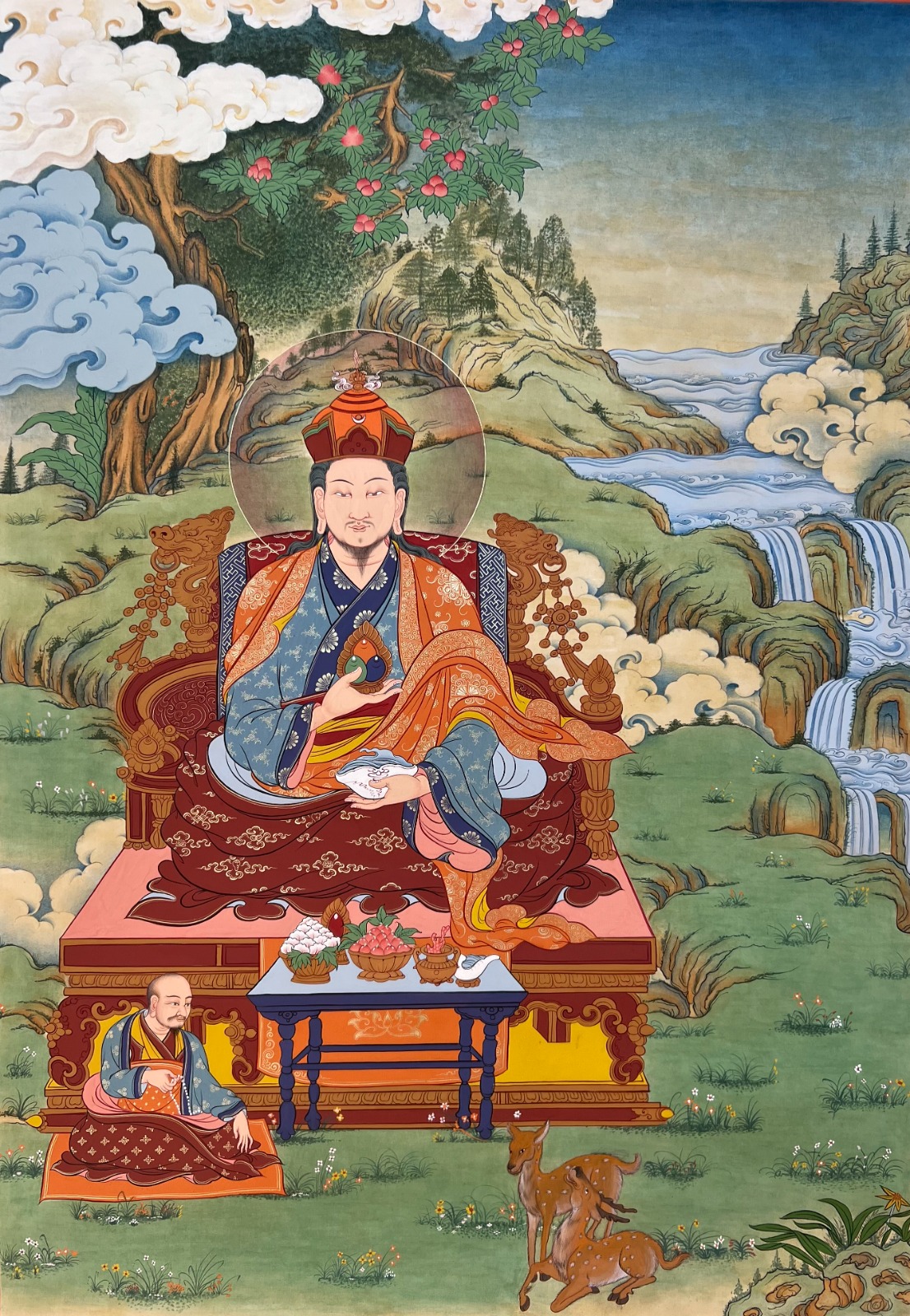
8th
Rigzin Chenpo Jigme Rabten(1885-1959)
རིག་འཛིན་ཆེན་པོ་འཇིགས་མེད་རབ་བརྟན། །
仁珍 千寶 吉美 喇殿 (1885-1959)
無畏永堅
སྐུ་ཕྲེང་བརྒྱད་པ།
དཔལ་ཛཾ་ཐང་ཛ་མགོའི་རི་ཁྲོད་དུ། །
ཆོས་སྦྱོར་བ་དྲུག་གི་ཉམས་ལེན་མཛད། །
གྲུབ་རྟགས་ཀྱང་ཆེ་མ་ཆུང་གསུམ་སྟོན། །
རིག་འཛིན་འཇིགས་མེད་རབ་བརྟན་ལ། །
སྙན་མོ་གླུ་ཡི་མཆོད་པ་འབུལ། །
དབྱངས་མཆོད་པ་འབུལ་ལོ་བཞེས་སུ་གསོལ། །
The Eighth Incarnation
In Nyangtang Drakkar's secluded realm,
He mastered the six supreme practices with devotion.
Naturally accomplished, manifesting divine powers,
To Rinchen Gyurme Lhundrup I pay homage.
I offer this melodious song of praise,
A devoted offering of beautiful sound.
The Eighth Incarnation (the fifth in the Katog lineage)
Rinchen Gyurme Lhundrup (1885-1959) was one of the heart disciples of the First Dudjom Rinpoche. He was renowned as a treasure revealer of exceptional virtue, naturally accomplished in dharma nature, vast in wisdom, powerful in mind, and had countless disciples. He transmitted the Katog Rinchen Terdzod teachings in many places.
Born in Golok, he was recognised by the glorious Heruka Dudjom Lingpa as the reincarnation of his own previous teacher and was formally enthroned. In adulthood, he married the daughter of the Chakong chieftain and maintained the appearance of a yogin, wearing his hair long and white robes. Later, the First Dudjom Rinpoche gave him a palm-sized copper statue resembling himself, saying:
"Incarnation of Kanapa Apiya
Your activities, like the sun and moon, ceaselessly spread the great secret teachings"
(Kanapa meaning the Black Practitioner)
Thus inspired, he studied under Abong Rinpoche and Lingju Pema Lungrik Gyatso among others. He later went to Katog Monastery, where he received teachings and empowerments of both the Dundor and Longsal Nyingpo treasure teachings. He also received both old and new translation lineage empowerments and teachings. He widely taught the Dudjom New Treasure and Katog lineage teachings at Mula, Kangsa, and Awon Tsang monasteries.
When performing rituals for the Choku chieftain Washul to remove hidden curses, the lake waters boiled and cursed objects surfaced. When bandits were pillaging the area, he invoked Rahula's legacy in meditation. Immediately, black clouds gathered, thunder and lightning struck - some bandits fainted, others begged for mercy, recognising the yogin's power and seeking forgiveness, after which normalcy was restored. When fierce flames engulfed the Kangsa chief's residence, he was beseeched to save the people and property trapped inside. The master uttered a powerful "PHAT", struck the ground with his hat, and the fire instantly extinguished.
Particularly noteworthy were his realisation and wisdom through practice. In the Amdo region, the renowned master Achung Rinpoche invited him to give many teachings and empowerments at his monastery. Upon leaving, at Achung Rinpoche's earnest request, he turned his horse back three times to make aspirations for the monastery's flourishing - this connection is considered one of the causes for the prosperity of Achung Monastery and its teachings.
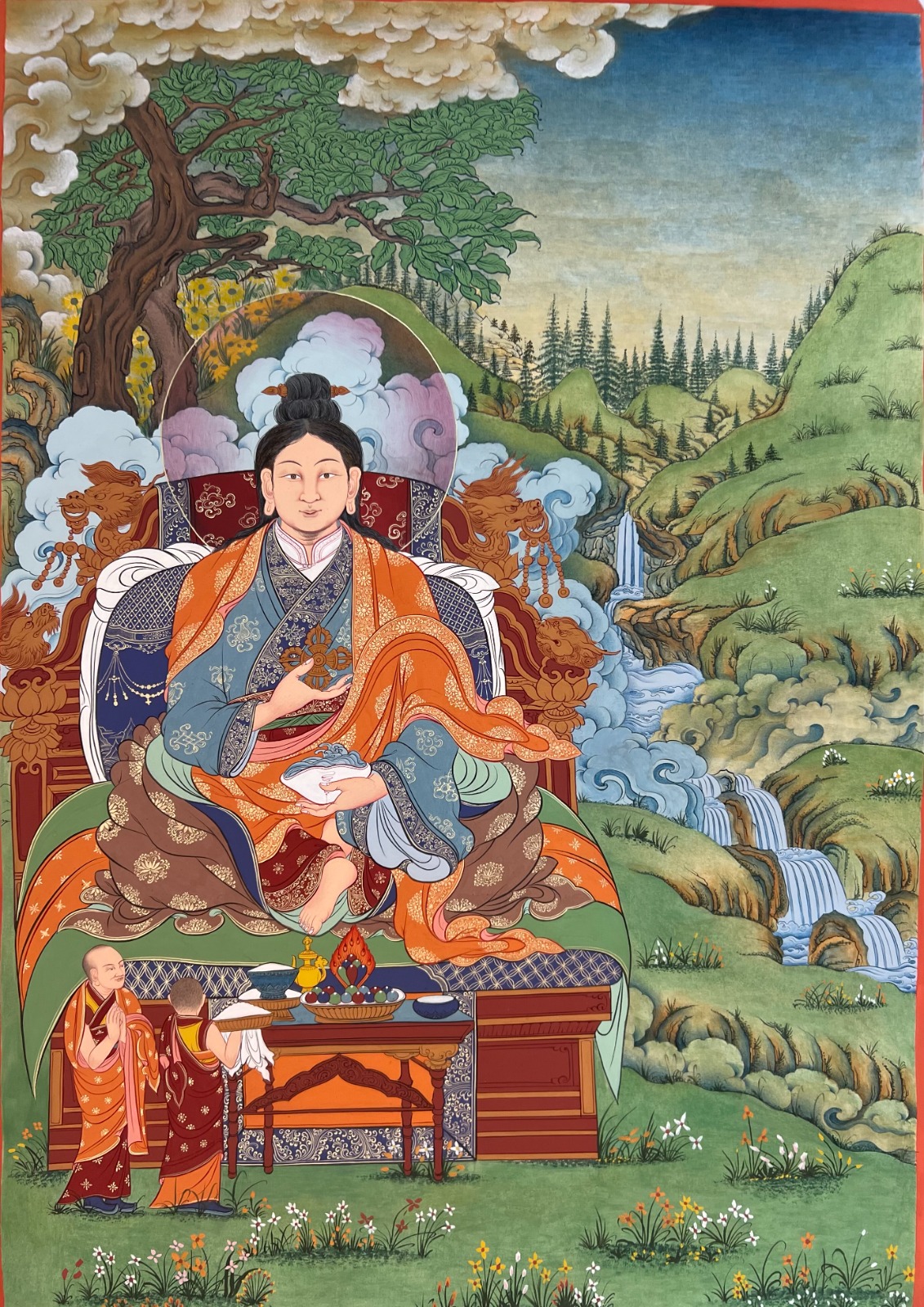
9th
Rigzin Chenpo Padma Wangchen (1973~)
རིག་འཛིན་ཆེན་པོ་པདྨ་དབང་ཆེན་ལ། །
仁珍 千寶 貝瑪 旺千(1973~)
蓮花大懷
སྐུ་ཕྲེང་དགུ་པ།
ཕ་རིག་འཛིན་གོང་མས་ལུང་བསྟན་ཅིང་། །
དམ་ཆོས་དགོངས་པ་ཀློང་དུ་བརྡོལ། །
ཆོས་རྫོགས་པ་ཆེན་པོའི་རྣལ་འབྱོར་པ། །
རིག་འཛིན་པདྨ་དབང་ཆེན་ལ། །
སྙན་མོ་གླུ་ཡི་མཆོད་པ་འབུལ། །
དབྱངས་མཆོད་པ་འབུལ་ལོ་བཞེས་སུ་གསོལ། །
The Ninth Incarnation
Foretold by the supreme master of awareness,
In whom the profound dharma wisdom has blossomed.
To the great yogic practitioner of Dzogchen,
To Rigzin Padma Wangchen, the master of awareness,
I offer this melodious song of praise.
Please accept this musical offering of devotion.
The Ninth Incarnation (the sixth in the Kathog lineage) The present incarnation, Rigzin Padma Wangchen, of Tibetan-Mongolian descent, is the son of the Ju family's reincarnate lama Ngawang Osel. While still a child, he was recognized as the reincarnation of the great Rinchen Chowang Drakpa by several eminent masters, including the treasure revealer Kangtsang, Karma Chagme of Pelyul Monastery, Lama Chatral Risa, and the Golok Rinpoche. 👉Click view more
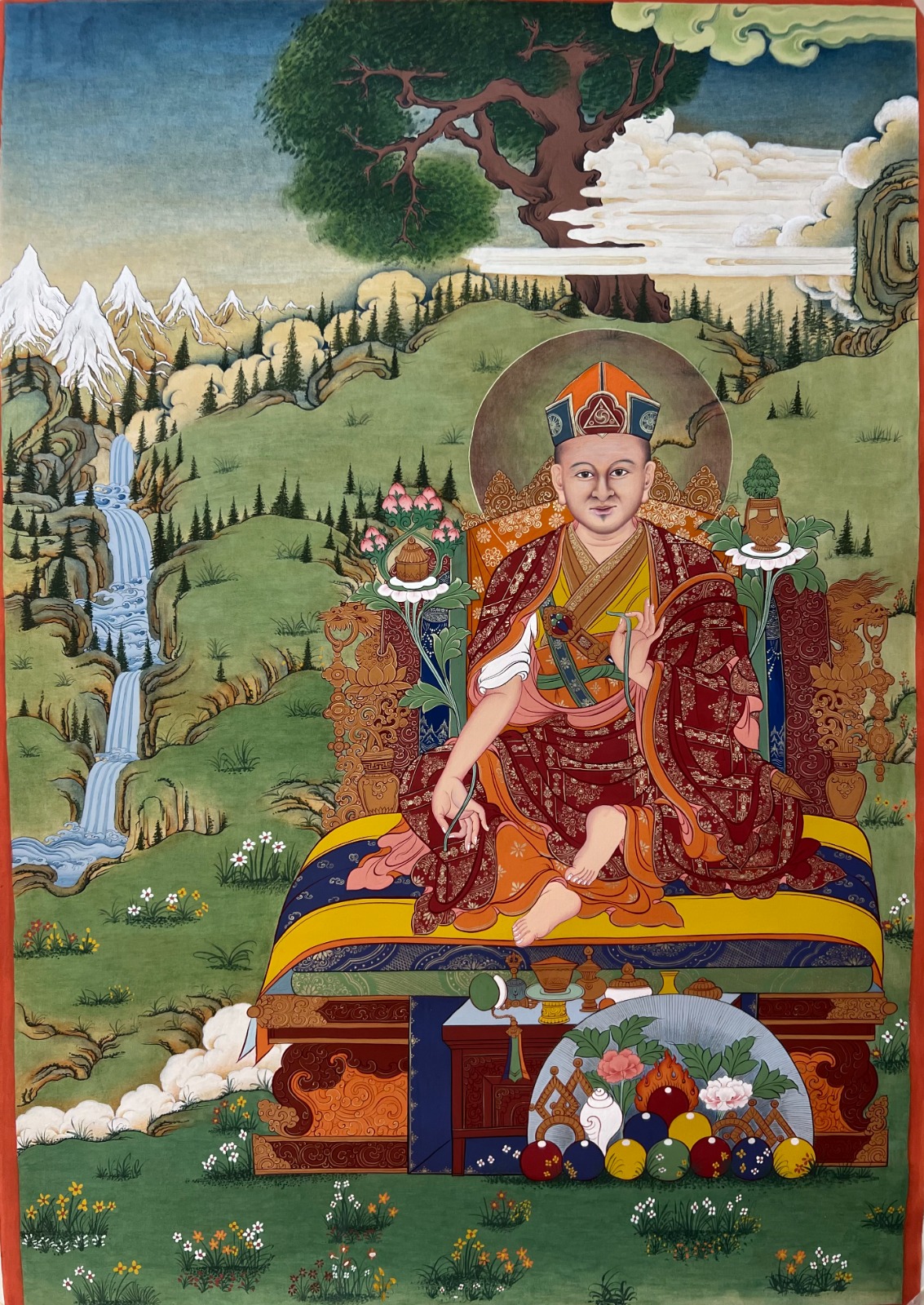
སྙིང་འདབ་བརྒྱད་པདྨའི་གདན་སྟེང་ན།།
འབྲལ་བ་མེད་དོ་ཐུགས་རྗེས་ཅན།།
དྲིན་ཆེན་རྩ་བའི་བླ་མ་ལ།།
སྙན་མོ་གླུ་ཡི་མཆོད་པ་འབུལ།།
དབྱངས་མཆོད་པ་འབུལ་ལོ་བཞེས་སུ་གསོལ།།
On the eight-petaled lotus throne in my heart, Throughout the six periods of day and night, Never separated, O Compassionate One, To my most kind root guru, I offer this melodious song as an offering, I present this musical offering - please accept it.
This is a traditional guru devotion prayer expressing deep reverence and gratitude to one's spiritual teacher. The imagery of the eight-petaled lotus represents the heart chakra where the guru is visualised, and the "six periods" refers to the traditional division of day and night in Buddhist practice.
